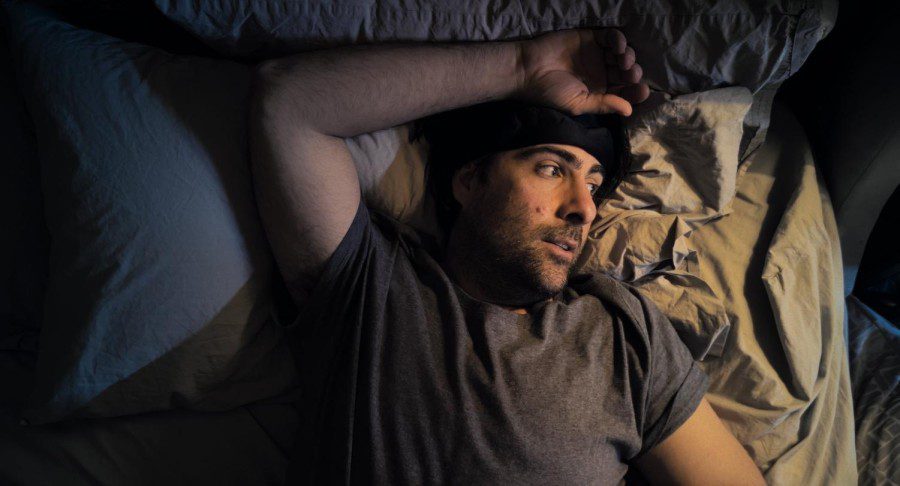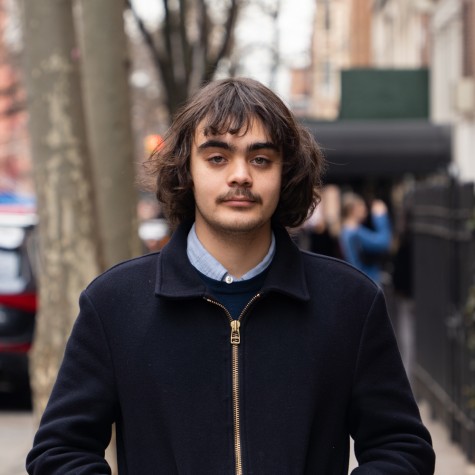Q&A: American auteur Andrew Bujalski explores the faith we put in films
WSN spoke with independent filmmaker Andrew Bujalski about mumblecore, Hollywood filmmaking and his time at Harvard University with Chantal Akerman and Dušan Makavejev.
Jason Schwartzman in “There There,” a Magnolia Pictures release. (Courtesy of Magnolia Pictures, Photo by Matthias Grunsky)
November 16, 2022
Andrew Bujalski is a mainstay in contemporary American independent film. His directorial debut, “Funny Ha Ha” (2002), sent a rippling effect across the festival scene with its masterful rendering of young adult ennui, and his subsequent films have all shown different sides of the shapeshifting auteur. After flirting with the mainstream following the success of 2018’s “Support the Girls” and penning Disney’s live-action “Lady and the Tramp” (2019), Bujalski appears to have returned to his roots with “There There.”
[Read more: ‘There There’ shoots for real emotions, despite its fake portrayal of them]
“There There” updates his musings on young aimlessness by tracing its continuity into the middle age. Shot during the pandemic, the film stitches together scenes featuring actors that appear to be in the same space, despite the fact that they were never on set at the same time. The final product is a strange meditation on communication and isolation, seamlessly held together by the illusion of continuity. WSN sat with Bujalski to discuss this latest feature.
This interview has been edited for length and clarity.
WSN: You’ve been anointed the “godfather of mumblecore.” How does that title sit with you nowadays, and what do you make of the so-called movement’s trajectory?
Bujalski: I’ve grown more comfortable with that word than I was 15 years ago. But it was always a little absurd, because nobody ever set out to make a mumblecore movie. There was never a movement per se. What I’ve come to understand or appreciate about when people throw that word around is that it speaks more to a generational moment — a combination of shared backgrounds and preoccupations that a few of us were reacting to at the time. Perhaps there were some shared values, but there was never an aesthetic, it was never anything anyone intended. As far as it being something that might be carved on my gravestone, I think I’m at peace with that.
WSN: As it pertains to your latest film, “There There,” much has been stated about the unique way by which it was shot — similar remarks were made around the time you shot “Computer Chess” on old video cameras. Is form something that comes first to you as a filmmaker when getting ready to make a movie?
Bujalski: One way or another form is one of the first things you have to take into account, even if you’re just saying, “OK, our form is that we’re making something fairly conventional.” Even that brings certain ideas about visual approach, structure — everything. I don’t think I really know how to conceive of anything without thinking about form and whatever limitations I have to face. You’re dealing with some limitations, so knowing what those are helps.
In this case, we took on a rather extreme formal limitation and that informed everything. I started to think about how our staging would work, what we could get out of it, what that would mean for my story as I was conceiving it; all of which is to say, I wouldn’t have tried to tell this story any other way. It was built for this form.
WSN: Where did the story begin?
Bujalski: When we got into pandemic-lockdown times, there was a period of maybe three months when nobody could do anything, and after that, people started to come back and there were a lot of bubbles, a lot of strategies people found to cope. It was very difficult, especially during those first movies made after the three-month mark. Now, in an odd way, for the Hollywood people, they’ve always worked in a bubble model anyway, so all they had to do was throw another $10 million at strengthening their bubble.
But thinking about all this, thinking about how movies are made, I started to get this idea that was less about lockdown and more about cinema. This idea that you’re always collapsing time and space on screen. I got excited about that and said, “What if we take this idea and pull it apart.”
When you cut from one actor to another, maybe a few hours have passed or maybe the other person already got home, you really never know. I thought if we treated that concept like a piece of taffy and really stretched it out to where the actors are thousands of miles apart, months apart, then what do we get when still trying to capture the intimacy movies get at?
This thematically then became really interesting to me because I’m always interested in relationships, when people are trying to reach across a divide. We were just trying to make that literal, and that led me to think about all the kinds of relationships that require trust and faith to survive, and what happens when that trust and faith is frayed. These relationships started to spark in my mind and the connections between the scenes, both the literal ones where one character goes from one scene to another and thematic things like motifs, started to appear.
WSN: When I watched the film, I didn’t realize these gaps in time and distance between the characters because of the editing’s extreme appeal to continuity. Where some filmmakers might have stressed these elisions, why did you uphold seamlessness in the editing process?
Bujalski: The funny thing is it’s really hiding in plain sight. Different people experience it in different ways. Some people figure it out immediately, and others never notice it. When you look at that first scene she’s in a room with white walls, and he’s in a room with green walls, but here we are telling you it’s the same room. It becomes apparent how the mind is so eager to stitch things together, to make it be one place. Now, that’s another kind of faith.
What I loved when I watched the movie was this sense that these performers are imagining themselves into existence. You watch Lili Taylor and Lennie James in that first scene, and it’s like you’re seeing Lili’s imagination of Lennie and Lennie’s imagination of Lili. They make each other.
WSN: Going back to your formal considerations and how you have previously stressed what you’re shooting a movie on — 16mm for “Funny Ha Ha” or analog video for “Computer Chess.” What was it like shooting on an iPhone?
Bujalski: In some ways, because everyone in the movie is isolated in the sense that you never see two performers in the same shot, it was important for us to make sure you did not feel the presence of anyone else in the room. We didn’t want it to feel like there was any other crew, and the camera never moves. We were trying to do this as simply as possible, and we chose to use an iPhone just as a practical consideration because all of our equipment fit in a case that we would just ship to wherever.
Once we got into it and started playing with the iPhone and with FilMic Pro, it started to get exciting because you can get into a lot of weird stuff. Anytime you’re dealing with a unique camera, especially a camera that has limitations does interesting stuff with those limitations, that got us excited about what kind of play we could do. As a result, the film looks rather surreal at many points.
We also knew that because we didn’t want to feel the crew and we didn’t want the camera to be making subtle adjustments to keep up with the actors, that we would have a lot of odd framing. That was fun. I had about 80 hours of footage. Sometimes things look odd and you go, “Well, this is horrible and no one could stand watching this,” and you just throw it out. But everyone once in a while you get a little piece of gold and you go, “This is a lighting, this is a framing, this is a shot that no one ever would have ever composed on purpose and yet it sings, it has some magic to it.” Those were always delightful discoveries.
WSN: I wanted to go back to what you’d said about Hollywood being a bubble. At this point in your career, you’ve worked in Hollywood, but also completely on your own. What’s that been like?
Bujalski: It’s different hats really. Most of my Hollywood work has been as a writer, so it’s easy enough for me to separate and say, “If I get hired by Disney, I am under no illusions that they hired me to be an auteur.” I understand that I am an employee there, I want to try to be a good employee and I want to listen to them to give them what they want to the best of my ability.
When I sit down to write something like “There There,” all that professionalism goes out the window because there’s no boss. I don’t have the North Star of, “What’s being asked of me?” All I have is the North Star of, “What is making me do this? What is in me that is sending me down this path?” And those are often not easy to answer.
It’s a different mode of writing. Not only at the outset, on the first draft, do I write quite differently, but also, as I go forward with my own stuff, it tends to be a refining process where I’m looking and trying to figure out what resonates with what I need to make something happen. Whereas, when I am in a professional situation and somebody says, “OK, we read your first draft, now change everything. We decided that we want this and this and this,” you just say, “OK!” and do your best. It’s not the same kind of inward procedure.
WSN: Being a student newspaper, we often like to ask about any advice filmmakers have for future ones. You studied at Harvard University under Chantal Akerman and Dušan Makavejev. How did you go about developing relationships with these mentors and carry these relationships beyond your college years?
Bujalski: I was very lucky to be in the right place at the right time when they were teaching. For me, a kid from the American suburbs, to find myself in the room with European artists of such great caliber with such an incredible level of commitment — I don’t think I ever met a more committed artist than Chantal Akerman — was extraordinary. It was a great inspiration and a great lesson. I did keep in touch with both of them, not to an extraordinary degree, but there were occasional emails or what-have-you over the years, and I felt incredibly lucky to have them in my life, and I’m very sorry that they’re both gone now. I still carry around a lot of it with me.
Contact Nicolas Pedrero-Setzer at [email protected].

























































































































































